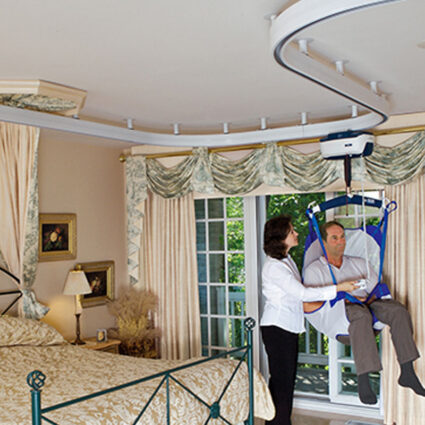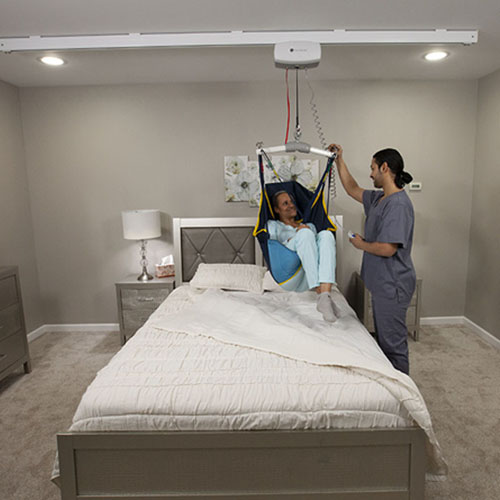Ceiling Lifts

General Information for Ceiling Lifts

A ceiling lift is a motorized device that lifts and transfers a person from point to point along an overhead track. The track can be ceiling mounted or may be portable (free-standing track). The device incorporates a sling for the person being transferred. A fully motorized ceiling lift transfers in an up and down motion, as well as from laterally along the length of the rail. A portable ceiling lift transfers a patient in an up and down motion using a motor; moving the person side to side is done manually. Ceiling lifts provide a safer way to handle patients for transfers in the bedroom, bathroom, and other areas of the home. Caregivers and patients are both safer when a lift is utilized.
Learn more at Savaria Ceiling Lifts
 The Independent Lifter was designed to provide independence and freedom to various transfer situations. In a combination with a Handicare Patient Lifts, the Independent Lifter removes the need for a sling and gives simplicity and accessibility for convenient application from situations including swimming pools, toilets, showers, and others. The Independent Lifter is perfect for home care where simplicity, independence, and safety are needed.
The Independent Lifter was designed to provide independence and freedom to various transfer situations. In a combination with a Handicare Patient Lifts, the Independent Lifter removes the need for a sling and gives simplicity and accessibility for convenient application from situations including swimming pools, toilets, showers, and others. The Independent Lifter is perfect for home care where simplicity, independence, and safety are needed.
Learn More at Savariapatientcare.com
Ceiling Lift Products

C-450 Fixed Ceiling Lift

Savaria Monarch Portable lift
Some things to think about when choosing a home patient or ceiling lift are:
 The length of Use – A free standing or pressure mounted post system with a lift is a good solution when the need is temporary or during a recovery period.
The length of Use – A free standing or pressure mounted post system with a lift is a good solution when the need is temporary or during a recovery period.
Healthcare Advice– An occupational or physical therapist can help you narrow down your selection for your needs based on your condition and requirements.
Portability – Select a portable lift if you’d like to use it in different rooms or take it with you to a different home. They weigh less than 10 pounds and come with a carrying case.
Ceiling – An installed ceiling track generally does not require any local permits, but there are specific construction requirements for how the track is supported. There are also alternate methods of supporting the track such as wall brackets or wall posts.
Space Considerations – Check the measurements of the lift to make sure you can move it where it needs to go. A freestanding track requires space for the overhead stand. An installed ceiling track takes up the least amount of space.
Installation & Service
 We will set up your lift so that it is ready to use. They require assembly and installation. Ceiling track lifts must be installed by trained or certified dealers who understand how to assess your home for the integrity of the ceiling structure to carry the weight required. In addition the installer will determine the best method of supporting and mounting the overhead track. Since most lifts are battery powered, it is important to follow the owner’s guide on correct charging procedures. The owner’s manual will usually include a schedule for regular maintenance and a qualified dealer will be able to service the lift as needed. Most manufacturers have a network of trained dealers who can perform service and this is especially important if you have a breakdown within the warranty period.
We will set up your lift so that it is ready to use. They require assembly and installation. Ceiling track lifts must be installed by trained or certified dealers who understand how to assess your home for the integrity of the ceiling structure to carry the weight required. In addition the installer will determine the best method of supporting and mounting the overhead track. Since most lifts are battery powered, it is important to follow the owner’s guide on correct charging procedures. The owner’s manual will usually include a schedule for regular maintenance and a qualified dealer will be able to service the lift as needed. Most manufacturers have a network of trained dealers who can perform service and this is especially important if you have a breakdown within the warranty period.
Tips & Resources
 -Ceiling lifts add security for the patient and reduce injury risk for the caregiver.
-Ceiling lifts add security for the patient and reduce injury risk for the caregiver.
-We will show you how to properly use the lift and transfer slings.
-Lift height capability varies model to model, some have the ability to lift a patient from the floor if needed.
-Installed ceiling lifts that go from room to room will require a certified installer. This ensures proper layout and minimizes safety issues due to the complexity of additional components and options.

